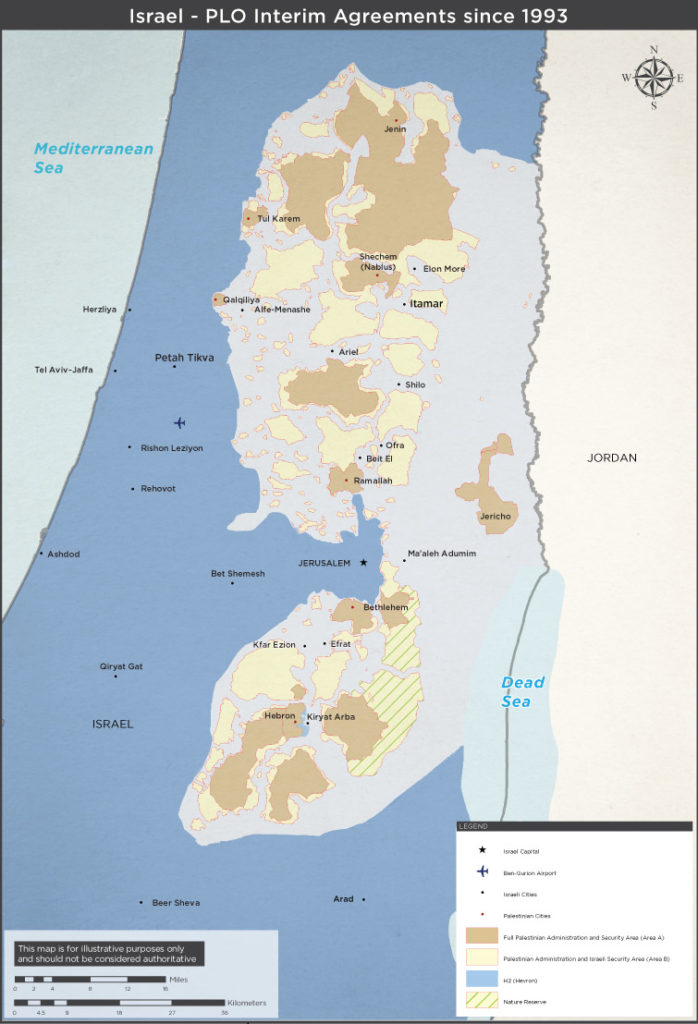FACT SHEETS
Arab-Israeli Peace Plans
August 13, 2020 | AIJAC staff

This fact sheet is current as at November 2020.
SUMMARY
There have been numerous attempts to bring peace to the Middle East by developing peace agreements between the Israelis and Palestinians. The only Arab-Israeli peace plan to mature into an agreement was the 1993 Oslo Accords. Israel has signed peace agreements with Egypt, in 1979, and with Jordan, in 1994.
THE FACTS
Basic principles
Most peace plans between the Palestinians and Israelis have addressed the same few elements with variations:
Two-state solution
Since the beginning of the 1990s, most Arab-Israeli peace plans have envisioned the creation of a Palestinian state next to the state of Israel, this is often abbreviated to “two state solution”.
While the 1993 Oslo Accords solidified the two-state solution as the goal to aim for, it also adopted Palestinian sub-statehood, at least as a temporary stage. This led to the creation of a self-governed Palestinian Authority in the Oslo Accords that was supposed to evolve into a state after five years. However, the Palestinian Authority remains the governing body of the Palestinians even today.
According to the Oslo Accords, the Palestinians assumed control of most the Gaza Strip. The West Bank was divided into three areas: Zone ‘A’ under full Palestinian Authority control (18% of the total land of the West Bank), Zone ‘B’ (22% of land in the West Bank) where the Palestinian Authority has civil control and security is jointly managed by Israel and the Palestinian Authority, and Zone ‘C’ (60% of land in the West Bank), which is under full Israeli civil and security control.

Israel-PLO proposals since 1993.
Image: Government of Israel
Land for Peace
Land for Peace is a formula in which Israel agrees to hand over territory under its control in exchange for peace with its Palestinian neighbours. This formula was woven into international law in two UN Security Council resolutions – Security Council Resolution 242 (1967) and Security Council Resolution 338 (1973) passed after the Six Day War and the Yom Kippur war respectively.
Various peace plans suggest different areas and locations for territory Israel is required to hand over to Palestinian control, and/or to neighbouring Egypt, Syria or Jordan.
The definition of what constitutes peace is up to interpretation. However, the essential Israeli demand is that this peace would include secure and recognisable borders for Israel, accompanied with proper security arrangements. Israeli governments also determined that peace should also include full diplomatic relations between the neighbouring country and Israel, and in some cases, recognition of Israel as a Jewish state.
Refugees and “Right of Return”
Following Israel’s 1948 War of Independence, which the Palestinians label ‘Nakba’ (catastrophe), approximately 750,000 Arabs living in mandatory Palestine became refugees. They gathered in refugee camps in the Gaza Strip, the West Bank and in Arab countries – Lebanon, Syria, Egypt, Iraq and Jordan. An additional 300,000 Palestinians became refugees after the 1967 Six Day War. As of 2020, 5.5 million Palestinians are registered as refugees by the special UN agency, the United Nations Relief and Works Agency for Palestine Refugees (UNRWA). This is due to UNRWA’s unusual approach to allowing refugee status to be automatically passed on to future generations, in contrast to the approach of the United Nation’s main refugee agency, which only confers refuee status on dependents in very limited circumstances.
The Palestinian narrative enshrines the “Right of Return” – a myth that all refugees, together with family members born in the many years since the ‘Nakba’, hold the right to return to live within the borders of Israel. Israel does not accept this idea because allowing a large number of non-Jews to settle inside that country would change its demography and signal the end of Israel as a Jewish state.
Peace plans have suggested that Palestinian refugees can resettle within the borders of a Palestinian state created alongside Israel. In addition, and/or instead, refugees could accept reparations and compensations, and be absorbed in locations outside Israel.
Status of Jerusalem
Both sides consider Jerusalem as central to their national identity. The city has been the seat of Jewish sovereignty since the rule of King David around 3000 years ago, and is now the capital of the modern state of Israel. The Palestinians have accepted the idea posited in several peace plans that the eastern area of Jerusalem, which was under Jordanian rule until 1967 and is populated mostly by Arab residents, will be the future capital of their own state.
Most sensitive is the disagreement regarding sovereignty over Judaism’s most holy site, the Wailing Wall or Kotel, and Islam’s Al-Aqsa mosque and Dome of the Rock –situated side by side on the Temple Mount or Haram al Sharif. Past peace plans suggested the Israelis and Palestinians would have different levels authority of over the holy places – from complete sovereignty, to custodianship or just municipal responsibility.
Significant peace plans
Allon Plan (1967)
The Allon Plan was the first Israeli peace plan, crafted by Israeli General Yig’al Allon. The plan proposed that the West Bank would be under Palestinian autonomy or a joint-Israeli-Palestinian confederation. Though never adopted as an official government position, it was regarded by many as a starting point for future negotiations until the 1990s. It was also used to justify building Israeli settlements in the West Bank, allegedly in line with the Israeli territory proposed in the maps contained in the Allon Plan maps.
Egypt-Israel peace agreement (1979)
On March 26, 1979, Egypt’s Anwar Sadat and Israel’s Menachem Begin signed a peace treaty in Washington DC. The two countries had previously been involved in significant military battles, including the War of Independence in 1948, the Six-Day War in 1967 and the Yom Kippur War in 1973. Since the signing of the treaty, the neighbours have enjoyed economic cooperation and there is security cooperation between the two, including over the administration of Gaza and over Islamists terrorists present in the Sinai.
Jordan-Israel peace agreement (1994)
On October 26, 1994, Jordan’s Prime Minister Abdul-Salam Majali and Israel’s Prime Minister Yitzchak Rabin signed a peace treaty. The treaty enhanced regional security, broadly, as well as security cooperation between the two countries. The full economic advantages of the treaty have never been realized, although it opened up the border to tourists and traders. Some tensions do remain between Israel and Jordan, but peace has held since the treaty was signed.
The Camp David Summit (2000)
During the Camp David Summit, Israeli Prime Minister Ehud Barak concluded the process toward a two-state solution, offering Palestinian Liberation Organisation chairman Yasser Arafat control over 73% of the West Bank and all of the Gaza Strip. Within 10 to 25 years, under Israel’s offer, the area for a Palestinian state was to be widened to up to 94% of the West Bank, including parts of east Jerusalem. Israel would also agree to dismantle more than 60 settlements in the West Bank. The Palestinians rejected the offer. In his biography, US President Bill Clinton, who hosted the summit, wrote: “I regret that in 2000, Arafat missed the opportunity to bring that nation into being and pray for the day when the dreams of the Palestinian people for a state and a better life will be realised in a just and lasting peace”.
Arab Peace Initiative (2002)
Considered the flagship of Arab peace plans, the Arab Peace Initiative was adopted by the Arab League. It called for two states, including full Israeli withdrawal from the West Bank, Gaza, the Golan Heights and east Jerusalem and a “just settlement” of the refugee issue based on UN Resolution 194 (1948). In return, ties between Israel and the Arab world would be normalized, that is Arab states would offer Israel full diplomatic recognition. Negotiations on this proposal never proceeded.
Olmert Peace Plan (2008)
Israeli Prime Minister Ehud Olmert and President of the Palestinian Authority Mahmoud Abbas negotiated a plan toward a two-solution. It was considered by many Israelis as offering the most concessions ever made by Israel to the Palestinians. Olmert suggested that a Palestinian state would be created on 94% of the West Bank, Israel would oversee the evacuation of sparsely Jewish populated and isolated West Bank settlements, and there would be Palestinian sovereignty over Arab neighborhoods in east Jerusalem. The Old City of Jerusalem would be jointly managed by five nations: Israel, Palestine, Saudi Arabia, Jordan and the US. Abbas rejected the deal.
Trump Peace to Prosperity (2020)
Initiated by the United States under President Donald Trump. The Peace to Prosperity plan envisions the creation of a Palestinian state alongside Israel, and the development of the Palestinian economy thanks to a substantial aid package. It also calls for naturalisation of Palestinians refugees in their current locations in the diaspora, revoking their refugee status, and disassembling UNRWA. The Palestinians did not participate in negotiations.
Abraham Accords (2020)
Signed in Washington DC in the presence of US President Donald Trump, the declaration between Israel, the United Arab Emirates (UAE) and Bahrain is a framework for peace between the sides, leading to full diplomatic relations and normalisation of ties.
These accords differ from previous agreements because they are with Arab states that do not share a border with Israel. They also solidify decades of covert and low key political, security and economic cooperation between Israel and the UAE and Israel and Bahrain.
The negotiations between Israel and the UAE to reach these accords included an assurance that a proposal by Benjamin Netanyahu’s Government to extend Israeli sovereignty to areas of the West Bank would be suspended for the time being, but also language effectively recognising that, as “children of Abraham”, like Muslims, the Jewish people have legitimate roots in the region.
The Abraham Accords appear to represent a significant shift from the previous Arab paradigm which insisted that normalisation of relations with Israel could only be agreed to after a solution is reached regarding the Palestinian issue.
Furthermore, Israel’s relationship with the UAE and Bahrain is expected to be considerably warmer than past peace deals with Egypt and Jordan, involving much more people-to-people contact and economic cooperation.
Other Muslim and Arab countries are expected to forge similar agreements with Israel as a result of Abraham Accords.
The first one among those countries was Sudan, which publicly agreed to normalisation with Israel in October 22, 2020.
Tags: Egypt, Israel, Jordan, Palestine, Palestinian, peace plan, Trump, two state solution





